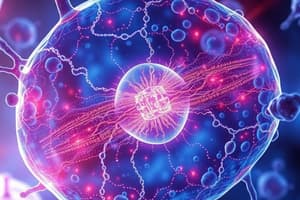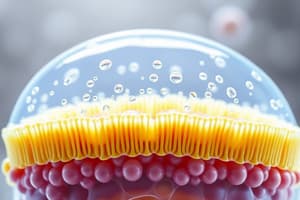Podcast
Questions and Answers
Which statement accurately describes the plasma membrane?
Which statement accurately describes the plasma membrane?
- It prevents any form of substance movement into or out of the cell.
- It consists of a double layer of phospholipids with embedded proteins. (correct)
- It is permeable to all substances without exception.
- It is a rigid structure that maintains cell shape.
What is the primary function of mitochondria within a cell?
What is the primary function of mitochondria within a cell?
- DNA replication
- Energy production (correct)
- Photosynthesis
- Protein synthesis
Which description best defines cytokinesis?
Which description best defines cytokinesis?
- The division of nuclear material during cell division.
- The process of chromosome pairing during meiosis.
- The splitting of the cytoplasm into two daughter cells following mitosis. (correct)
- The synthesis of DNA in the S phase.
Which organelle is often referred to as the 'suicide bag' of the cell?
Which organelle is often referred to as the 'suicide bag' of the cell?
Which statement is true regarding the difference between SER and RER?
Which statement is true regarding the difference between SER and RER?
Study Notes
General Properties of Cells
- Cells are the basic unit of life, exhibiting characteristics such as growth, metabolism, and reproduction.
- All cells contain a plasma membrane, cytoplasm, and genetic material (DNA).
- Cells can be prokaryotic (without a nucleus) or eukaryotic (with a nucleus).
Dynamic Nature of Plasma Membrane
- Plasma membrane is a phospholipid bilayer with embedded proteins, allowing selective permeability.
- Its fluid mosaic model describes the flexible nature of membrane lipids and proteins, facilitating movement and communication.
- The membrane's dynamic nature enables processes like endocytosis and exocytosis.
Plasma Membrane
- Composed of phospholipids, cholesterol, and proteins, aiding in cell signaling and transport.
- Functions include providing structural support, acting as a barrier, and regulating substance movement.
- Integral and peripheral proteins play vital roles in transport and communication.
Movement of Substances Across Cell Membrane
- Transports include passive (diffusion, osmosis) and active (requires energy) mechanisms.
- Facilitated diffusion uses carrier proteins to help substances cross membranes along their concentration gradients.
- Endocytosis and exocytosis enable bulk transport of materials into and out of the cell.
Mitochondria
- Known as the powerhouse of the cell, responsible for ATP production through cellular respiration.
- Double-membraned organelle containing its own DNA and ribosomes, indicative of an evolutionary past.
- Plays a role in metabolism, energy production, and apoptosis.
Ribosome
- Composed of ribosomal RNA and proteins, serving as the site for protein synthesis.
- Exists as free ribosomes in the cytoplasm or bound to the endoplasmic reticulum.
- Ribosomes translate mRNA into polypeptides, crucial for cellular function.
Stages of Mitosis
- Mitosis consists of prophase, metaphase, anaphase, and telophase; responsible for cell division and replication.
- Prophase: Chromatin condenses into chromosomes, and nuclear envelope breaks down.
- Metaphase: Chromosomes align at the cell’s equator.
- Anaphase: Sister chromatids are pulled apart to opposite poles.
- Telophase: Nuclear membranes reform around the separated chromatids.
Meiosis
- A two-stage process of cell division resulting in four non-identical haploid cells.
- Meiosis I involves homologous chromosome separation, while Meiosis II resembles mitotic division.
- Key for sexual reproduction, essential for gamete formation.
Key Definitions and Concepts
- Symport: A type of transport where two different substances move in the same direction across a membrane.
- Suicide Bag: Refers to lysosomes, containing enzymes for breaking down waste materials and cellular debris.
- Difference Between SER & RER: Smooth Endoplasmic Reticulum (SER) lacks ribosomes, involved in lipid synthesis; Rough Endoplasmic Reticulum (RER) has ribosomes, aiding in protein synthesis.
- Cytokinesis: The process where the cytoplasm divides, resulting in two daughter cells after mitosis or meiosis.
- Components of Plasma Membrane: Phospholipids, cholesterol, proteins (integral and peripheral), and carbohydrates.
Studying That Suits You
Use AI to generate personalized quizzes and flashcards to suit your learning preferences.
Description
Explore the fundamental characteristics of cells, including their structure and function. This quiz delves into the details of the plasma membrane's role in cell dynamics, covering aspects like selective permeability and the fluid mosaic model. Test your knowledge on prokaryotic and eukaryotic cells as well!




